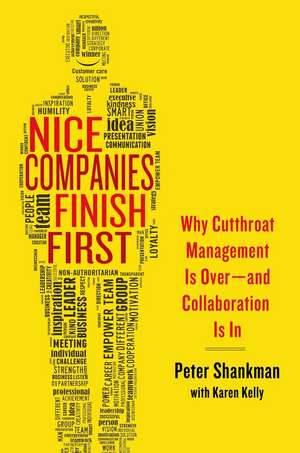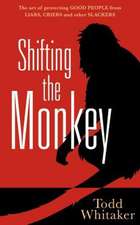Nice Companies Finish First: Why Cutthroat Management Is Over--And Collaboration Is in
Autor Peter Shankman Karen Kellyen Limba Engleză Paperback – 2 iun 2014
| Toate formatele și edițiile | Preț | Express |
|---|---|---|
| Paperback (1) | 107.18 lei 3-5 săpt. | |
| Palgrave MacMillan – 2 iun 2014 | 107.18 lei 3-5 săpt. | |
| Hardback (1) | 116.53 lei 22-27 zile | |
| Palgrave – apr 2013 | 116.53 lei 22-27 zile |
Preț: 107.18 lei
Nou
Puncte Express: 161
Preț estimativ în valută:
20.51€ • 22.37$ • 17.29£
20.51€ • 22.37$ • 17.29£
Carte disponibilă
Livrare economică 03-17 aprilie
Preluare comenzi: 021 569.72.76
Specificații
ISBN-13: 9781137279156
ISBN-10: 113727915X
Pagini: 245
Dimensiuni: 168 x 233 x 20 mm
Greutate: 0.27 kg
Editura: Palgrave MacMillan
Locul publicării:Basingstoke, United Kingdom
ISBN-10: 113727915X
Pagini: 245
Dimensiuni: 168 x 233 x 20 mm
Greutate: 0.27 kg
Editura: Palgrave MacMillan
Locul publicării:Basingstoke, United Kingdom
Descriere
The era of authoritarian cowboy CEOs like Jack Welch and Lee Iacocca is over. In an age of increasing transparency and access, it just doesn't pay to be a jerk - to employees, customers, competitors, or anyone else. In Nice Companies Finish First, Shankman, a pioneer in modern PR, marketing, advertising, social media, and customer service, profiles the famously nice executives, entrepreneurs, and companies that are setting the standard for success in this new collaborative world. He explores the new hallmarks of effective leadership, including loyalty, optimism, humility, and a reverence for customer service, and shows how leaders like Jet Blue's Dave Needleman, Tony Hsieh of Zappos, Steve Jobs of Apple, Ken Chenault of Amex, Indra Nooyi of Pepsi, and the team behind Patagonia harness these traits to build productive, open, and happy workplaces forthebenefit of their employees,themselves, and the bottom line.
Notă biografică
Peter Shankman is the founder of Help a Reporter Out (HARO), the largest free source repository for journalists in the world, as well as thefounder and CEO of The Geek Factory, Inc., a 15-year-old marketing, branding, and PR company based in New York City with clients worldwide. His PR and social media clients have included AmEx, Sprint, the US Department of Defense, Royal Bank of Canada, Snapple, Saudi Aramco, Walt Disney World, Discovery Networks, Harrah's Hotels, and many others. He is the author of Can We Do That?!, which has been named one of the six "must read" PR books by PR Channel.
Caracteristici
1) TIMELY INTERVIEWS WITH UP AND COMING CEOS: As the era of cult-of-personality CEOs like Jack Welch and Lee Iacocca ends amid outrage over massive bonuses, it's the perfect time to meet the next generation of famously nice executives like JetBlue's Dave Needleman andTony Hseih of Zappos.
2) GREAT SPEAKING AND MEDIA PLATFORM: Shankman is a huge presence in the online world, with over 150,000 followers on Twitter. He is beloved in the media for creating the listserv Help a Reporter Out, an open-source repository that has changed the way reporters work. He also speaks about 50 times a year, travelling across the country to conferences including Blogworld, South by Southwest, and the Public Relations Society of America. He's frequently quoted in leading publications like The New York Times, The Wall Street Journal, the Los Angeles Times, the New York Daily News, and USA Today.
3) STELLAR CLIENT LIST: Shankman's clients include AmEx, Sprint, the US Department of Defense, Royal Bank of Canada, Snapple, Saudi Aramco, Walt Disney World, Discovery Networks, Harrah's Hotels, and many others.
4) EMAIL AND MEDIA MARKETING: Shankman has a 200,000-name personal email list, which he will blast at publication time. He will also promote to the significant audience of HARO for both purchases and coverage.
2) GREAT SPEAKING AND MEDIA PLATFORM: Shankman is a huge presence in the online world, with over 150,000 followers on Twitter. He is beloved in the media for creating the listserv Help a Reporter Out, an open-source repository that has changed the way reporters work. He also speaks about 50 times a year, travelling across the country to conferences including Blogworld, South by Southwest, and the Public Relations Society of America. He's frequently quoted in leading publications like The New York Times, The Wall Street Journal, the Los Angeles Times, the New York Daily News, and USA Today.
3) STELLAR CLIENT LIST: Shankman's clients include AmEx, Sprint, the US Department of Defense, Royal Bank of Canada, Snapple, Saudi Aramco, Walt Disney World, Discovery Networks, Harrah's Hotels, and many others.
4) EMAIL AND MEDIA MARKETING: Shankman has a 200,000-name personal email list, which he will blast at publication time. He will also promote to the significant audience of HARO for both purchases and coverage.
Cuprins
1. What's So Great about Being a Nice Guy?
2. The Nine Warning Signs of a Hopeless Jerk
3. Trait #1: Enlightened Self-Interest
4. Trait #2: The Accessibility Factor
5. Trait #3: Strategic Listening
6. Trait #4: Good Stewardship
7. Trait #5: 360 Loyalty
8. Trait #6: Glass-Half-Full POV
9. Trait #7: Customer Service-Centric
10. Trait #8: Merit-Based Competitor
11. Trait #9: Gives a Damn
Conclusion: Nice Guys (and Gals) Are the Future of Business
Recenzii
"This book's subtitle- "Why cutthroat management is over- and collaboration is in"- says it all... This means you can no longer treat your boss one way and the people who report to you another...It seems as though politeness is back on an upward trajectory."
- Third Sector magazine, 3rd June 2013
"Shankman's book points out both the 'how to' and the 'why' of becoming a nice guy and a nice company. It is a compelling argument and one that every CEO should consider. Read it and apply the lessons to ensure your company too can exploit the positive traits of nice companies and the long-term rewards that can create."
-Brain Cram, May 29th 2013
- Third Sector magazine, 3rd June 2013
"Shankman's book points out both the 'how to' and the 'why' of becoming a nice guy and a nice company. It is a compelling argument and one that every CEO should consider. Read it and apply the lessons to ensure your company too can exploit the positive traits of nice companies and the long-term rewards that can create."
-Brain Cram, May 29th 2013









